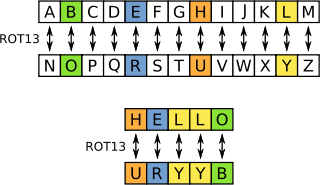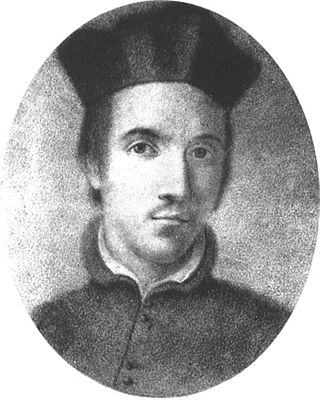In communications and information processing, code is a system of rules to convert information—such as a letter, word, sound, image, or gesture—into another form, sometimes shortened or secret, for communication through a communication channel or storage in a storage medium. An early example is an invention of language, which enabled a person, through speech, to communicate what they thought, saw, heard, or felt to others. But speech limits the range of communication to the distance a voice can carry and limits the audience to those present when the speech is uttered. The invention of writing, which converted spoken language into visual symbols, extended the range of communication across space and time.

In cryptography, a cipher is an algorithm for performing encryption or decryption—a series of well-defined steps that can be followed as a procedure. An alternative, less common term is encipherment. To encipher or encode is to convert information into cipher or code. In common parlance, "cipher" is synonymous with "code", as they are both a set of steps that encrypt a message; however, the concepts are distinct in cryptography, especially classical cryptography.

In cryptography, encryption is the process of encoding information. This process converts the original representation of the information, known as plaintext, into an alternative form known as ciphertext. Ideally, only authorized parties can decipher a ciphertext back to plaintext and access the original information. Encryption does not itself prevent interference but denies the intelligible content to a would-be interceptor.

Musical notation is any system used to visually represent auditorily perceived music, played with instruments or sung by the human voice through the use of symbols, including notation for durations of absence of sound such as rests. For this reason, the act of deciphering or reading a piece using musical notation, is known as "reading music".
In cryptography, a substitution cipher is a method of encrypting in which units of plaintext are replaced with the ciphertext, in a defined manner, with the help of a key; the "units" may be single letters, pairs of letters, triplets of letters, mixtures of the above, and so forth. The receiver deciphers the text by performing the inverse substitution process to extract the original message.

ROT13 is a simple letter substitution cipher that replaces a letter with the 13th letter after it in the Latin alphabet. ROT13 is a special case of the Caesar cipher which was developed in ancient Rome.

The Vigenère cipher is a method of encrypting alphabetic text where each letter of the plaintext is encoded with a different Caesar cipher, whose increment is determined by the corresponding letter of another text, the key.
In music, solfège or solfeggio, also called sol-fa, solfa, solfeo, among many names, is a mnemonic used in teaching aural skills, pitch and sight-reading of Western music. Solfège is a form of solmization, though the two terms are sometimes used interchangeably.

The Playfair cipher or Playfair square or Wheatstone–Playfair cipher is a manual symmetric encryption technique and was the first literal digram substitution cipher. The scheme was invented in 1854 by Charles Wheatstone, but bears the name of Lord Playfair for promoting its use.
In computer programming, Base64 is a group of binary-to-text encoding schemes that transforms binary data into a sequence of printable characters, limited to a set of 64 unique characters. More specifically, the source binary data is taken 6 bits at a time, then this group of 6 bits is mapped to one of 64 unique characters.

The Dorabella Cipher is an enciphered letter written by composer Edward Elgar to Dora Penny, which was accompanied by another dated July 14, 1897. Penny never deciphered it and its meaning remains unknown.
The numbered musical notation is a cipher notation system used in Mainland China, Taiwan, Hong Kong, and to some extent in Japan, Indonesia, Malaysia, Australia, Ireland, the United Kingdom, the United States and English-speaking Canada. It dates back to the system designed by Pierre Galin, known as Galin-Paris-Chevé system. It is also known as Ziffernsystem, meaning "number system" or "cipher system" in German.

Francesco Antonio Rosetti was a classical era composer and double bass player, and was a contemporary of Haydn and Mozart. There is considerable confusion regarding his name. The occasional mention of a supposed, but non-existent, "Antonio Rosetti born 1744 in Milan", is due to an error by Ernst Ludwig Gerber in a later edition of his Tonkünstler-Lexikon having mistaken Rosetti for an Italian in the first edition of his own Lexikon, and therefore including Rosetti twice - once as an Italian, once as a German-Czech. Many sources claim that he was born Franz Anton Rösler, and changed his name to an Italianate form by 1773, but according to a 1792 article by Heinrich Phillip Bossler, who knew Rosetti personally, he was named Rosetti from his birth.

The pigpen cipher is a geometric simple substitution cipher, which exchanges letters for symbols which are fragments of a grid. The example key shows one way the letters can be assigned to the grid.
Paradigmatic analysis is the analysis of paradigms embedded in the text rather than of the surface structure (syntax) of the text which is termed syntagmatic analysis. Paradigmatic analysis often uses commutation tests, i.e. analysis by substituting words of the same type or class to calibrate shifts in connotation.
The trifid cipher is a classical cipher invented by Félix Delastelle and described in 1902. Extending the principles of Delastelle's earlier bifid cipher, it combines the techniques of fractionation and transposition to achieve a certain amount of confusion and diffusion: each letter of the ciphertext depends on three letters of the plaintext and up to three letters of the key.
Notation plays a relatively minor role in the oral traditions of Indonesian gamelan but, in Java and Bali, several systems of gamelan notation were devised beginning at the end of the 19th century, initially for archival purposes.

Francesco Lana de Terzi was an Italian Jesuit priest, mathematician, naturalist and aeronautics pioneer. Having been professor of physics and mathematics at Brescia, he first sketched the concept for a vacuum airship and has been referred to as the Father of Aeronautics for his pioneering efforts, turning the aeronautics field into a science by establishing "a theory of aerial navigation verified by mathematical accuracy". He also developed the idea that developed into Braille.

BATCO, short for Battle Code, is a hand-held, paper-based encryption system used at a low, front line level in the British Army. It was introduced along with the Clansman combat net radio in the early 1980s and was largely obsolete by 2010 due to the wide deployment of the secure Bowman radios. BATCO consists of a code, contained on a set of vocabulary cards, and cipher sheets for superencryption of the numeric code words. The cipher sheets, which are typically changed daily, also include an authentication table and a radio call sign protection system.
A musical cryptogram is a cryptogrammatic sequence of musical symbols which can be taken to refer to an extra-musical text by some 'logical' relationship, usually between note names and letters. The most common and best known examples result from composers using musically translated versions of their own or their friends' names as themes or motifs in their compositions. These are not really rigorous cipher algorithms in the formal sense, but more like musical monograms. The methods used historically by composers were either too incomplete or too simplistic to meaningfully encrypt long text messages. There is a separate history of music ciphers utilizing music notation to encode messages for reasons of espionage or personal security that involved encryption and/or steganography.
















